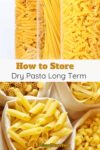Dry pasta is one of the best foods to store for emergencies.
When stored properly, pasta can last over 25 years and still be good to eat.
In this article, I’ll go over pasta shelf life, which types of pasta are best for long-term stockpiling, and exactly how to store pasta.
How Long Does Dry Pasta Last?
Even without any special storage methods, dry pasta has a very long shelf life.
Most studies put the shelf life of semolina pasta stored in its original packaging in a pantry at approximately 2 to 3 years past its “best by” date.
When protected against moisture, pasta can easily last 10+ years. Egg pasta, gluten-free pasta, and flavored pasta also have a long shelf life but, depending on what ingredients they contain, could go bad sooner.
Why Pasta Goes Bad
Dry pasta has almost no moisture in it. Without moisture, bacteria and mold are unable to grow. The pasta will remain safe to eat for years or even decades. However, there are some ways that pasta can go bad.
- Mold and bacteria growth: When stored in humid or wet conditions, pasta can grow bacteria or mold. The mold usually looks like dark greenish-blue spots on the pasta.
- Nutrient loss: Heat and oxygen will destroy nutrients (particularly vitamins). The pasta is still safe to eat but won’t have as much nutritional value.
- Going rancid: Some types of pasta contain a lot of natural oils. These will go rancid in warm temperatures and when exposed to air.
- Absorb odors and contaminants from the environment: After several years in storage, dry pasta can start to taste musty. It will also absorb chemicals from the environment, including from its plastic packaging and the glues used in the box.
- Pests: Pantry pests usually prefer whole grains, beans and seeds. However, they will eat pasta (especially whole-grain pasta). While it may seem gross, it is safe to eat insect-infested pasta. Read more about pantry pests and food storage.
Dry Pasta Shelf Life by Type
- Semolina Pasta: It should last at least 2 years in the pantry but could be fine for 10+ years, even without special storage.
- Egg Pasta: Egg pasta will last approximately 2 years without any special storage. It may become discolored and lose nutrients though. Egg pasta also has a tendency to absorb odors and contaminants from the air around it.
- Vegetable Pasta: Pasta with vegetable flavors (such as spinach or beet pasta) also lasts 2 years without special storage. It might discolor or lose nutrients, but should still be safe to eat.
- Whole-Grain Pasta: Just like storing whole-grain flour, the natural oils in whole-grain pasta will cause it to go rancid. The process is gradual. After a year or two, the pasta may still be safe to eat but have an unpleasant taste.
- Gluten-Free Pasta: Most gluten-free pastas will last 2 years in the pantry. However, some gluten-free pasta is made with ingredients that have a lot of natural oils (such as flax pasta). The oils in the pasta will cause the pasta to go bad much faster – especially in warm temperatures.
How to Store Pasta Long Term
1. Remove Pasta from Its Original Packaging
You will need to repackage it for long-term storage. The reason is that the original packaging is not air-tight: it will allow moisture, odors, and contaminants through.
Even if the pasta remains “safe” to eat, it can develop a really gross taste. On top of that, studies show that pasta will absorb the chemicals (like glue on the box) from the packaging. So, it’s better to remove pasta from its packaging for long-term storage.
2. Choose the Right Containers
The container must be completely air-tight so moisture from the air doesn’t get through. There are several options:
- Mylar bags: These are generally considered the best container for long-term food storage. They are cheap, come in different sizes, and are fairly easy to seal. Read about Mylar for food storage.
- Jars: Jars with air-tight lids (such as mason jars or canning jars) are good for storing smaller amounts of food. The downside is that jars will easily break during earthquakes, tornadoes, and other disasters so protect them. Don’t use recycling jars with threaded lids; moths and other pests can follow the grooves and easily get inside the jars!
- Food grade plastic: Most plastic food containers don’t really have an air-tight lid, so are not suitable for long-term storage. This is why I personally prefer Mylar. Here are some good options for food storage containers.
- Buckets: An easy way to store large amounts of pasta is to put it in a bucket. You can get gasket lids that provide an air-tight seal. Because the lids can leak though, it’s still best to put the pasta in other containers before putting them in buckets.

What about vacuum sealing pasta?
Vacuum sealing will remove air from around pasta, thus improving shelf life. The problem is that vacuum sealer bags are not completely air-tight. They will eventually start to leak over time.
For this reason, they aren’t ideal for long-term food storage. One solution is to first vacuum seal pasta and then put it in buckets with gasket lids. The combination provides better protection from air and moisture.
3. Add Oxygen Absorbers
Oxygen absorbers (OAs) are little packets that absorb oxygen from the air. Because oxygen is one of the things which causes food to spoil, using them can increase shelf life drastically. You’ll definitely want to use oxygen absorbers with any enriched pastas, flavored pastas, egg pastas, or pasta with a higher oil content (like whole-grain pasta).
Normal semolina pasta doesn’t really go bad from oxygen exposure. So, it’s not absolutely necessary to use OAs for it. However, I still use them in my pasta storage to preserve taste and prevent pests.
To use oxygen absorbers, you’ll need to add the appropriate amount in CCs before sealing the container. Read more about oxygen absorbers for food storage here.
4. Protect Against Pests
Because pasta is heat-treated, it is highly unlikely that it contains any insect eggs when you buy it. Thus, it isn’t usually necessary to freeze pasta before storing to protect against pests. Mice are a big problem as they can easily chew through Mylar or even plastic containers.
Put Mylar bags of pasta in food-grade buckets with lids. Keep the buckets and any other plastic food containers at least 6 inches off the floor and 2 inches away from walls. Also be sure to check on your food storage regularly and look for chew marks or other signs of pests.
5. Keep Somewhere Cool
Your pasta will last longer if it is kept somewhere cool, so keep it away from water heaters, washing machines and anything else that produces heat.
Live in a tiny home? Here are some actionable ideas about where to store prepping supplies when short on space.
Don’t Forget a Way to Cook Pasta!
If you are storing pasta for emergencies like power outages, you’ll also need a way to cook the pasta. Read about these 22 ways to cook without power and see our picks for best indoor emergency stoves and best survival stoves.
https://sanremo.com.au/about/f-a-q/,
https://www.sciencedirect.com/science/article/abs/pii/S0926669014005937,
https://www.tandfonline.com/doi/abs/10.1080/19440049.2014.999259,
https://onlinelibrary.wiley.com/doi/abs/10.1111/j.1365-2621.1981.tb04197.x



Can hamburger helper, scalloped potatoes etc that have spices/Seasoning included be stored in a Wallaby bag? What about ramen noodles with spices?
Yes, you can. But the shelf life will be shorter with mixed ingredients/meals like those than if you’d stored just pasta. The spices will still be safe to eat for a long time, but they quickly lose their flavor, even when stored in Mylar with OAs.
What do you think would be the useful life of a dry gluten-free pasta that is packaged directly in cardboard boxes?
So long as it isn’t high-fiber or whole grain (these have natural oils in them which can go rancid), pasta can really last a LONG time (years or even decades) without any special packaging. But I would be worried about it being packaged just in cardoard. The pasta will start to absorb moisture from the air and could potentially get moldy. At the very least, it will start to absorb weird smells and tastes. And cardboard packaging isn’t exactly disaster-proof. At the very least, I’d put it a plastic container with a good lid.
What about gluten free pasta made from White rice and corn? Does the corn shorten the shelf life? And do I still use oxygen absorber?
The corn shouldn’t shorten the shelf life (not by anything really noticable, anyway). For long-term storage, oxygen absorbers are still the best way to go. Otherwise, just rotate through the pasta within a couple years. Pasta lasts for a stupidly long time even without special packaging.
Hi! How long do you think gluten free pasta made of just brown rice would last? It’s in a Mylar bag with oxygen absorbers.
Brown rice has a lot of natural oils. Even with OAs, fats will start to go rancid over time (especially in heat). So, look at the fat content of the pasta. If there’s more than 2g of fat (per 100g), the shelf life will probably be around 5 years instead of 10+. Not guaranteeing anything though — it could last longer or shorter depending on how warm your climate is!
Hi! If I were to seal pasta in mason jars with a vaccuum sealer would I still need to add the oxygen absorber? Approximately how long would they be good for I mason jar with and without oxygen absorber. Thank you!
Pasta can last DECADES even without any special storage. Since the vacuum sealer jars keep moisture out of the pasta (the main thing which will make pasta go bad), I’m guessing they would be fine for at least 5 years (if not 25+ years). Since the jars are glass, you’d be able to occassionally look into them for signs of spoilage, such as color changes.
Personally though, I don’t like storing things long term in mason jars. Earthquakes, tornadoes, hurricane winds… I’d rather my emergency food was packaged in a way which would survive an emergency and not end up shattered all over the floor.
Hi. New to trying to keep pasta longer term. I know boxed can keep quite awhile, even with the bug,(boiling them, kills them). I dud buy the large heavy glass metal and glass sealed jars and put some in there for macaroni and some dried northern beans. And dried split peas. The lids have rubber seals and snap tightly. I haven’t opened them at all. I kept in the kitchen away from light for awhile. Than made space in our basement, cool and dark. We got a vacuum sealer and have been using that now. Still want to buy a dehydrator that is good and inexpensive. So much to learn and do.
Thank you, Diane C.
Can I store dry pasta in a large ziplock baggie and then maybe keep inside a container with a lid? I was thinking about stocking up on things like pasta (Walmart is always near out of stock most of the time) and I thought it would be a good idea to buy in bulk when I can and just circulate
That’s definitely not the best option, but should be okay if you rotate through it within a year or two. Just make surey you also have an emergency stove so you can cook all that pasta during a power outage! 🙂
What about egg noodles?
Egg noodles aren’t recommended for long-term storage. They contain a lot of fats. The fats will cause them to go rancid. Even if stored with oxygen absorbers, the fats still go rancid — especially in hot temperatures.
Great read. Thanks for the tips and reinforcing what I already knew.
Me too